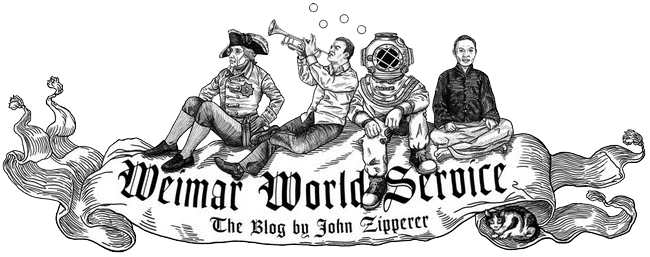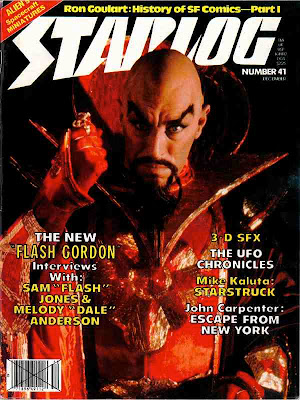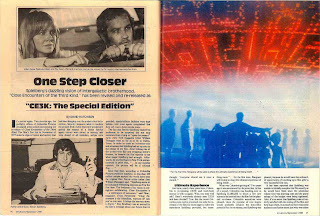Starlog #43
76 pages (including covers)
Cover price: $2.25
Beyond the economics of restrained page counts, I tend to think of this issue and the next as the beginning of a new phase of SF movies. Star Trek and The Empire Strikes Back are both still around and will continue to get coverage, but two earth-bound films get the most attention at this time: Scanners (on the cover of this issue, #43), and Altered States (on the cover of #44). Both of them are a bit brainier, a bit less fantastic (in the fantastic films sense), and probably a heck of a lot cheaper to make.
And to kick it off, we have a (non-bloody) photo on the contents page of a Scanner blowing up someone's head. Nice. Kerry O'Quinn's From the Bridge focuses on mind-blowing activities of another kind: the intellectual and emotional pleasures of truly enjoying fantasy; Communications letters range from Nick Tate fans defending their hero against (you guessed it) Fred Freiberger's comments in his (in)famous interview, readers also comment on Gerrold's own response to Freiberger, and more; Log Entries short news items include the planned NASA Space Shuttle Columbia launch for March 1981, a preview of The Incredible Shrinking Woman with Lily Tomlin, Tom Baker leaves Doctor Who, George Takei drops out of the race for the California state assembly, Star Trek is the latest science-fiction program that supposedly has never made money, and more.
Howard Zimmerman interviews Gary Kurtz, producer of Star Wars IV and V, about his plans post-Empire; David Gerrold gets into the trekkies-vs-trekkers controversy; Sam Maronie interviews director David Cronenberg about his new movie, Scanners; Brian Mossman records the first-ever meeting between Frankie Thomas (Tom Corbett, Space Patrol) and Ed Kemmer (Buzz Corry of Space Patrol); Gary Gerani provides an episode guide for The Incredible Hulk (seasons 1977-1980); James H. Burns interviews Robert Altman about his new movie, the Robin Williams-starring Popeye; Bjo Trimble's Fan Scene explores the Society for Creative Anachronism; Quest publishes "Terry's" black-and-white illustrations; Tone Hobart chronicles "The Fantastic Bubblegum Invasion" (which includes some data on recent SF-themed cards); it's part three of Ron Goulart's exploration of science-fiction comics, this time focusing on the 1940s; James H. Burns interviews Somewhere in Time director Jeannot Szwarc; David Hutchison uncovers the special effects of Paddy Chayefsky's Altered States; David Houston's "Golden Age of Science Fiction Television" explores "the Outer Space Bandwagon"; and Howard Zimmerman closes the issue in his Lastword column with some kind words about Scanners, a short review of the past year in SF, and watching NASA explore Saturn.
"Since I'm recommending things, I'd like to get in another book plug. This one's for Steven King's The Stand, definitely my favorite read of 1980. It's much closer to science fiction than any of King's other books and guaranteed to blow you away."
--Howard Zimmerman, editor, LastwordTo view previous Starlog issue descriptions, click on "Starlog Internet Archive Project" in the keywords below.


















































